Moving Bed Biofilm Reactor (MBBR) vs. Conventional Activated Sludge System (CAS)
By: Tom Frankel
Post Date: enero 26th 2022
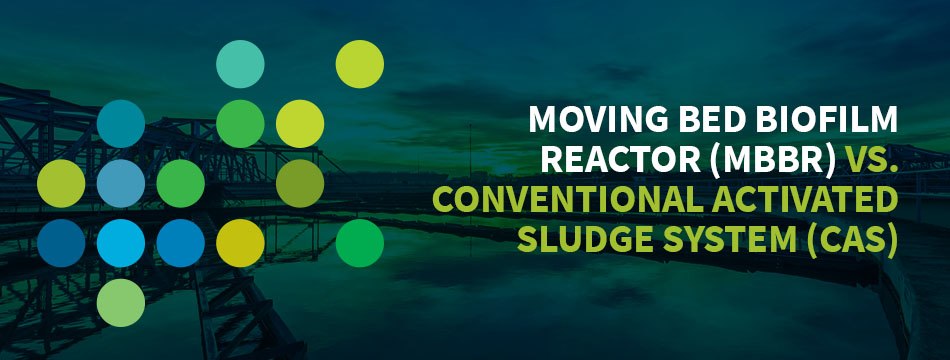
Communities and ecosystems around the world rely on wastewater treatment for healthy, clean water. Clean water is essential for both municipal and industrial use. It also helps reduce the transmission of diseases and ensures a sustainable, thriving environment for the generations to come.
One of the best ways to accomplish wastewater cleaning is through various aeration processes that work to remove dangerous substances from the water. What these processes leave behind is clean, healthy water that municipalities and businesses can safely release back into the environment. Two common water cleaning systems that organizations must choose between are the conventional activated sludge (CAS) system and the moving bed biofilm reactor (MBBR) system.
Table Of Contents
- Parts of a CAS System
- Benefits of CAS System
- Cons of CAS System
- Parts of an MBBR System
- Benefits of MBBR System
- Cons of MBBR
- MBBR Compared to Traditional Wastewater Treatment
- How Organizations Determine Which System Is Right for Them
- Contact the Experts at SSI Aeration, Inc. to Determine What System Is Right for You
Parts of a CAS System
The conventional activated sludge system is one of the most common processes of aeration for treating wastewater. Also called the traditional activated sludge system, this process has been around for over a hundred years, making it a tried and true method of cleaning water. The CAS process relies on microorganisms and aeration to separate sludge from the water. Several components and parts are necessary to make the CAS system work.
Various models of the CAS process exist, each with its own specific steps. Despite these differences across the various types of activated sludge processes, most CAS models — and many other systems of wastewater management — use many of the same standard parts and processes.
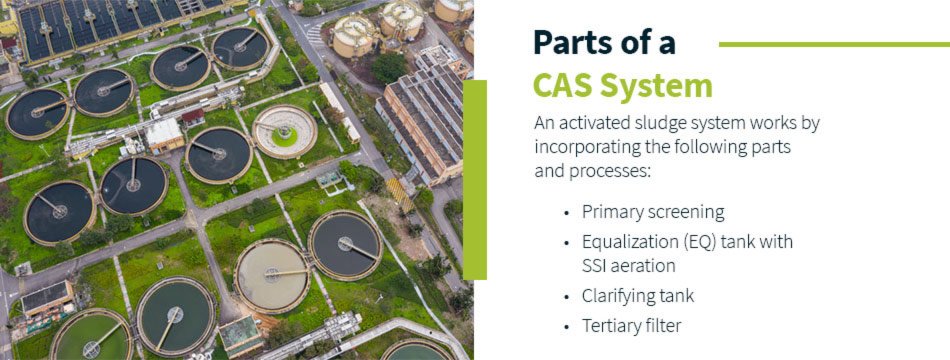
An activated sludge system works by incorporating the following parts and processes:
- Primary screening: This step forces wastewater through a screen of varying sizes to remove larger items like leaves, twigs and solid waste. Some people also refer to this step as the grit removal phase. Large impurities in the wastewater will settle to the bottom to allow for further clarification. The wastewater may take on a new term called “settled sewage,” as the larger pieces of waste have settled before the wastewater moves on to the next phase.
- Equalization (EQ) tank with SSI aeration: In this phase, wastewater travels to the primary sedimentation tank, or the EQ tank, where microorganisms known as flocs will naturally decompose organic waste in the water. The process of aeration injects this water with oxygen, which feeds these microorganisms and causes them to multiply.
- Clarifying tank: The influent wastewater then exits the EQ tank and travels to the clarifying tank. This tank also goes by the name “settling tank.” It’s in this tank that the microorganisms, or sludge blanket, start to settle and sink to the bottom of the tank. As this sludge settles, the water grows cleaner and reaches a state of greater clarification. The microorganisms then recycle into the EQ tank where they can break down more waste solids. They also will multiply over time, increasing their waste-decomposing qualities.
- Tertiary filter: Tertiary filters provide an added layer of treatment to many wastewater systems. These filters appear at the end of wastewater treatment systems to remove more total suspended solids (TSS) to produce cleaner effluent. This effluent can be used for purposes that require cleaner water. Organizations can also reintroduce effluent to the clarifying tank to repurpose the microorganisms for further waste decomposition. Most activated sludge system users may forgo this step, as it’s often unnecessary for bringing wastewater to safe levels for reintroduction to the environment.
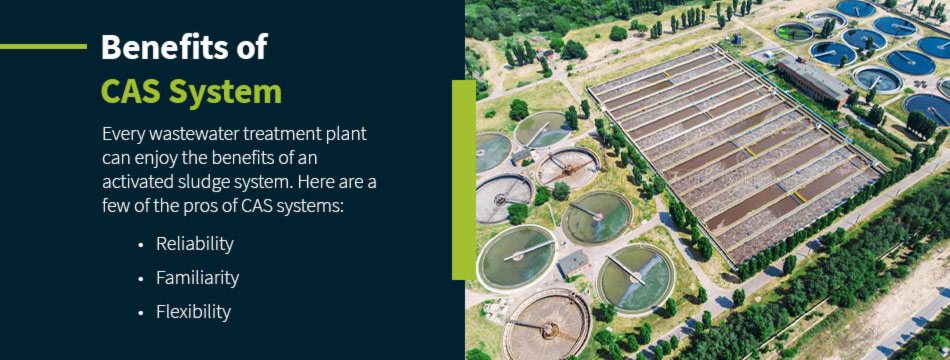
Benefits of CAS System
Every wastewater treatment plant can enjoy the benefits of an activated sludge system. Here are a few of the pros of CAS systems:
- Reliability: The CAS system of wastewater treatment is one of the most common and popular treatment systems because of its high level of reliability. This fact means a municipality or industrial plant can rely on it time and time again to clean influent for safe release back into the environment.
- Familiarity: More people in the wastewater treatment profession are familiar with CAS than other more modern, innovative systems. CAS has been around a long time, so much literature and experience exist on how to operate them. Should a malfunction occur, the fact that a technician may be able to easily fix the issue provides a great deal of peace of mind.
- Flexibility: An activated sludge system can also offer the flexibility various industries need to handle different types of loads. This fact has aided in its popularity since its introduction in the early 1900s and is one of the most appealing advantages of activated sludge. When a traditional wastewater treatment plant must process its soiled water, the flexibility of CAS wastewater treatment makes it a go-to choice.
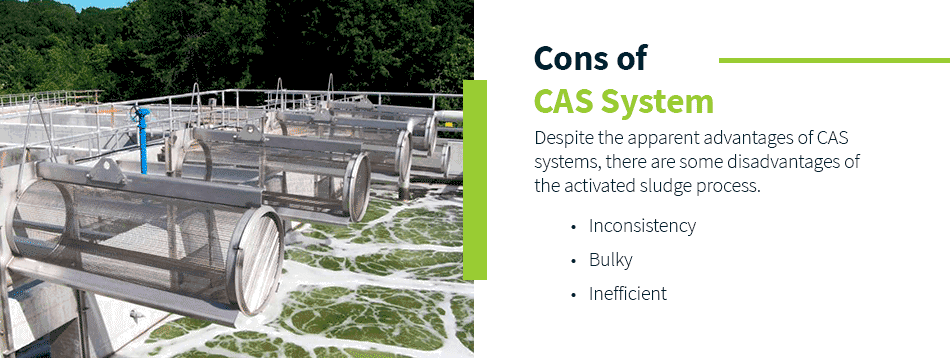
Cons of CAS System
Despite the apparent advantages of CAS systems, there are some disadvantages of the activated sludge process. The following list contains the cons of this classical wastewater treatment method:
- Inconsistency: The quality of the effluent that CAS systems produce can vary. While the effluent produced is consistently suitable for return to the environment — barring any malfunctions to the system — it may come short of the level of clarity an organization is looking for to achieve its purposes.
- Bulky: One of the most noticeable disadvantages of CAS wastewater treatment systems is their bulkiness. A simple process flow diagram will reveal that the steps and parts of CAS will take up a lot of space. Entities looking to save on space when treating their wastewater may want to consider a different method.
- Inefficient: CAS systems demand a lot of work for proper operation. The process of cleaning wastewater can be time-consuming. Businesses and municipalities looking for faster cleaning of their wastewater may want to look elsewhere for their treatment solution.
Parts of an MBBR System
While MBBR wastewater treatment is one of the more recent systems to arrive on the scene, it’s quickly solidified its place in the industry.
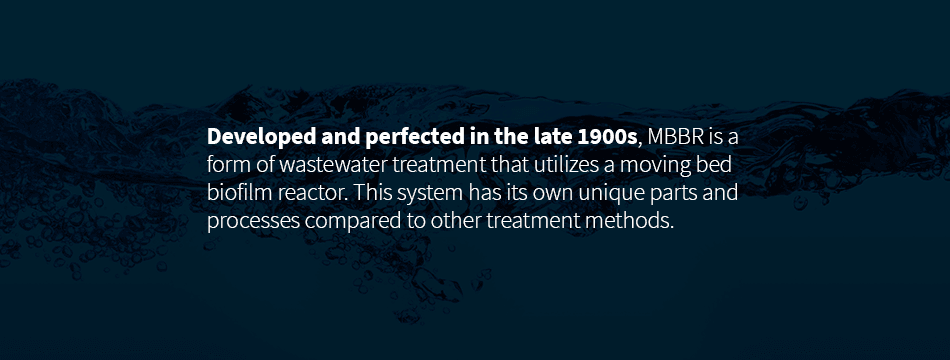
Developed and perfected in the late 1900s, MBBR is a form of wastewater treatment that utilizes a moving bed biofilm reactor. This system has its own unique parts and processes compared to other treatment methods.
The parts below reveal how MBBR works to clean dirty influent water and produce effluent that’s safe for reuse or release into the environment.
Basin
At the start of the MBBR process, the influent enters the basin which is also called the aeration tank or the reactor. It is in this open-topped tank that small microorganisms will break down solids in the water. The microorganisms are better able to accomplish this task thanks to two other critical components of the system: the media and the aeration grid. These components together allow the basin to be the sole part of the system where the majority of the wastewater treatment occurs.
Media
One of the more unique parts of MBBR design is the presence of media. Many people also refer to media as carriers because they “carry” the microorganisms throughout the basin. Media are small plastic pieces that increase the surface area within the water on which microorganisms can grow. And since pieces of media have a similar density to the water around them, they easily float through the water and disperse throughout the basin.
As the media move around the wastewater, the microorganisms have the opportunity to contact and break down more organic waste and clean the water for reintroduction into the environment.
Organizations in the process of MBBR media calculation must choose from the following list of standard types:
- Sponge-type carriers: This form of media boasts high mechanical strength, making them a great option for adequate movement throughout the basin. They also possess a high surface area with a rough texture, which is conducive to the microorganisms’ ability to take a firm hold on the media. Spong-type carriers are flexible, but this also causes them to wear out faster than other forms of media.
- Chip-type carriers: Chip media contain a high concentration of fine pores on a thin body. Their high level of flexibility gives them exceptional resistance to wear and tear as they travel throughout the wastewater basin.
- Coin-shaped carriers: This type of MBBR media is thin and coin-shaped, as its name implies. Coin-shaped carriers allow the filtration of wastewater into them from either side, reducing the chances of fouling. Some chip-type media may possess the coin shape, as well.
- Tube-shaped carriers: This form of MBBR media is thin and tube-shaped, giving it a great amount of surface area for microorganisms to cling to and grow. The tube shape is also conducive to even suspension throughout the water, limiting the pieces of media from stacking on top of each other. Their hollow nature does cause them to have a higher risk of fouling.
Aeration Grid
The aeration grid is a critical part of every MBBR wastewater treatment system. This component serves a dual purpose. First, it injects oxygen into the basin. The microorganisms feed off this oxygen and begin multiplying. The thriving of the microorganisms thanks to this injection of oxygen from the aeration grid is what allows the MBBR system to adequately break down organic waste in the water.
The second purpose of the aeration grid is to move the media around the tank. As the oxygen injects into the basin, it creates movement within the wastewater. This movement sends the media throughout the tank, allowing the microorganisms to spread throughout and decompose more of the organic solids.
Sieve
The sieve is another aspect of MBBR wastewater treatment. This crucial component is large enough to let water pass through it yet small enough to prohibit the microorganisms from escaping. This allows the microorganisms to continue their waste breakdown process for each subsequent load of influent.
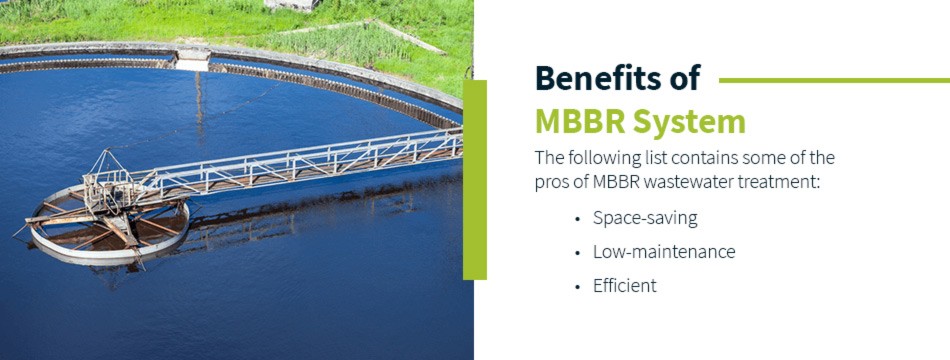
Benefits of MBBR System
Thanks to their modern design and intuitive features, MBBR wastewater systems provide many benefits to organizations, industrial plants and municipalities alike. The following list contains some of the pros of MBBR wastewater treatment:
- Space-saving: MBBR systems can save space, which is crucial when a small total footprint is essential. MBBR systems are able to achieve this small form factor by using a single tank for the entire process. The increased surface area for microorganisms provided by the floating media also helps reduce the MBBR system’s footprint.
- Low-maintenance: Processes common in other wastewater systems like backwashing or membrane-cleaning are nonexistent in MBBR systems. This fact makes them low maintenance and easy to use.
- Efficient: When efficiency matters to an organization, MBBR wastewater treatment could be the way to go. The entire process of cleaning a load of wastewater is much shorter in MBBR systems, lasting only a few hours.
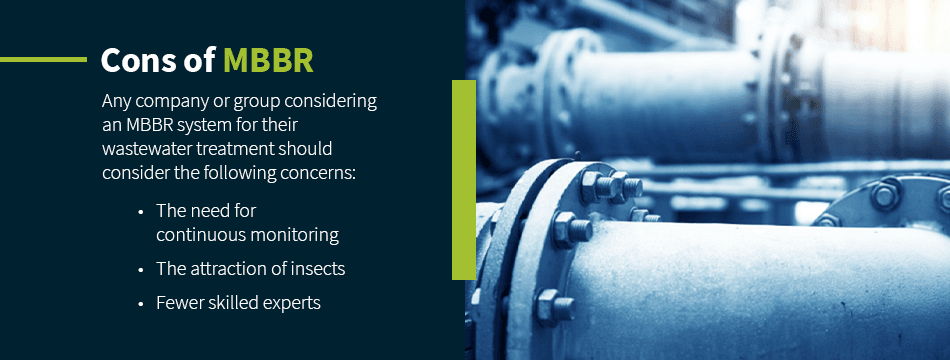
Cons of MBBR
MBBR systems have plenty of benefits that make them appealing for any entity in need of wastewater treatment. However, all systems come with their own list of potentially negative factors, depending on the user’s needs. Any company or group considering an MBBR system for their wastewater treatment should consider the following concerns:
- The need for continuous monitoring: Although MBBR systems need little maintenance or intervention, they do require a fair amount of monitoring to ensure proper functioning and quality of effluent.
- The attraction of insects: Insects have a way of finding and entering bodies of water where they’re unwelcome. The same is true of MBBR wastewater systems. The presence of these insects can cause problems, as the MBBR membranes may be unable to properly deal with them.
- Fewer skilled experts: The modern introduction of MBBR wastewater systems has its positives and its negatives. Despite its benefits, the newness of MBBR can make it more difficult for organizations to find skilled experts to inspect, repair and maintain their systems.
MBBR Compared to Traditional Wastewater Treatment
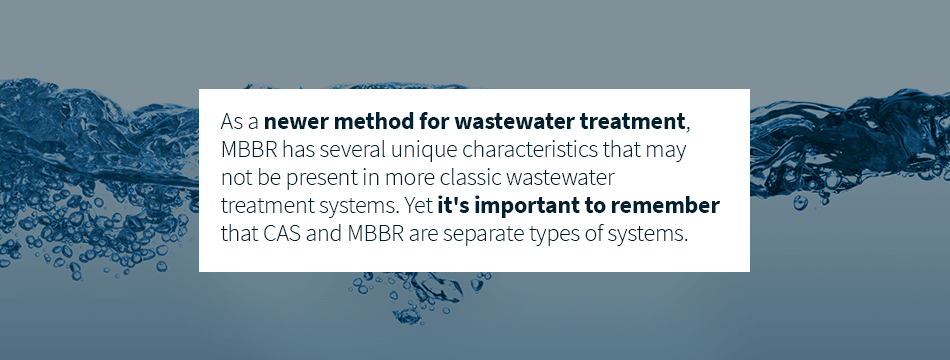
As a newer method for wastewater treatment, MBBR has several unique characteristics that may not be present in more classic wastewater treatment systems. Yet it’s important to remember that CAS and MBBR are separate types of systems. While one is not technically better than the other, one type may be better for an organization depending on their needs, restrictions and desires.
The following points recount the differences between conventional activated sludge and MBBR:
- Primary screening: CAS systems require compact primary screening to remove solids from influent so that the wastewater is easier to clean in the ensuing steps. MBBR functions without the need for primary screening, as the entire process takes place in a single basin.
- EQ tank with SSI aeration: Both CAS and MBBR require a tank to hold and clean wastewater with the help of microorganisms. Despite this similarity, both systems have different sized tanks — with the MBBR tank being about a third the size of the CAS tank — and hold influent water for differing lengths of time, with the MBBR system’s holding time being shorter.
- Bubble diffusers: During the aeration process, most CAS systems use coarse bubble diffusers, while MBBR systems use fine bubble diffusers. Fine bubble diffusers oxygenate the water more efficiently, while coarse bubble diffusers move the water around during aeration.
- Rapid clarification: The clarification stage is also different between CAS and MBBR. MBBR has a smaller clarifier on account of a lower concentration of solids. CAS systems have a larger clarifying tank to help decompose larger and greater amounts of solids.
- Tertiary filter: Both CAS and MBBR systems have a filter at the end of the process that keeps microorganisms in while allowing effluent out, either to be released in nature or repurposed for other uses. The amount of solids within the effluent differs between systems. Most MBBR systems have a lower TSS output than CAS systems.
- UV disinfection: Installing an MBBR system gives organizations the chance to install a UV disinfecting system on the tertiary filter. This adds an extra layer of cleanliness to the system to produce even cleaner effluent as it passes through the tertiary filter. Most CAS treatments will have to go without the added UV disinfecting system.
- Reaeration: The reparation process in a CAS system involves recycling the sludge back into the EQ tank for further growth and waste decomposition. MBBR systems skip this step entirely, as it forgoes the need for returned activated sludge. MBBR systems use the sieve to allow effluent out while keeping the microorganisms within the basin.
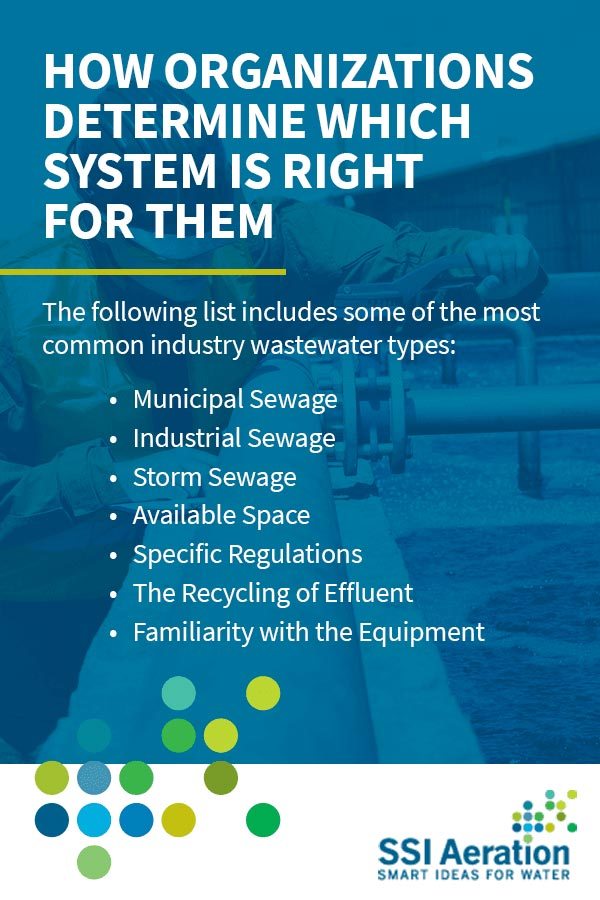
How Organizations Determine Which System Is Right for Them
When a municipality, organization or business needs to clean their wastewater, they have to ensure they’re choosing the system that best suits their needs. The first step is to know how the various types of wastewater differ from one another. The following list includes some of the most common industry wastewater types:
- Municipal sewage: This type of sewage includes the wastewater produced by commercial and residential buildings. Municipal sewage is the most common form of sewage and is the byproduct of everyday processes like running water, bathing, using the toilet and cleaning.
- Industrial sewage: This type of sewage is what’s leftover from various industrial processes. Examples include the pharmaceutical, textile, paper, petroleum, power production, food and beverage manufacturing industries. These industries rely on water and produce wastewater as a result. Thus, these industries need a wastewater treatment system to care for the environment and stay regulation-compliant.
- Storm sewage: Storm sewage includes the runoff and debris caused by severe weather. This type of wastewater may include items like rocks, twigs, mud and other side effects of heavy winds, precipitation, runoff and other natural weather patterns.
A few other factors exist that organizations must take into consideration when choosing their wastewater treatment plan. These include the following:
- Available space: The amount of available space is one of the main determining factors for choosing which wastewater treatment system is the right one. CAS systems take up more space than MBBR systems, so organizations dealing with a smaller footprint may choose MBBR. Organizations with more space to spare and a preference for CAS systems can feel confident installing a classic activated sludge system.
- Specific regulations: Different industries and businesses may deal with different regulations for the TSS in their effluent. These regulations will depend on the specific industry, the location and the intended use of the effluent after treatment. Every organization should familiarize itself with local, state and federal regulations to ensure the right wastewater treatment system is chosen.
- The recycling of effluent: How an organization plans to use their effluent will also play into their decision on which wastewater treatment system to install. Whether the organization is releasing its effluent back into the environment or repurposing it for drinking or cleaning, they’ll need to know what level of TSS in the effluent is acceptable.
- Familiarity with the equipment: Once a company installs a system, they’re going to need to maintain and properly operate it. While it may be easier to find a technician for a CAS system than an MBBR system, MBBR systems often require less intervention and maintenance.
Contact the Experts at SSI Aeration, Inc. to Determine What System Is Right for You
SSI Aeration, Inc. has been helping organizations across industries treat their wastewater for safe reuse or release into the environment since its founding in 1995 in Poughkeepsie, New York. Their wastewater treatment systems consist of high-quality materials so you can feel confident in your installation. SSI Aeration, Inc. continues its tradition of helping organizations clean their wastewater so they can stay regulation-compliant and help keep the environment is safer and cleaner for generations to come.
Contact SSI Aeration, Inc. today for more information on how they can meet your wastewater treatment needs.

Mr. Frankel co-founded SSI in 1995 with experience in design and distribution of engineered systems. He is in charge of sales, marketing and operations in the company. Mr. Frankel holds multiple US patents related to diffusers. He is a graduate of Washington University in St. Louis.


